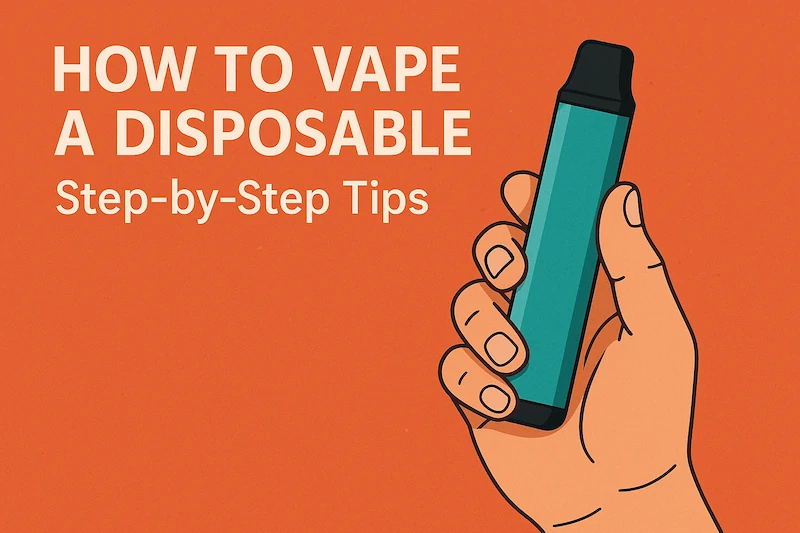If you’re a smoker and want to switch to vaping, disposable vapes are a great option because they’re easy to use and they don’t cause any hassle. These devices are specially made for beginners. They don’t need to be charged or refilled, and they’re easy to set up. Just unpack and take a puff to start them.
Unlike normal cigarettes, they give the same handheld feel and inhalation rhythm of smoking, which makes the change easier without overwhelming users. Their small, pocket-sized design makes them perfect for when you’re out and about, whether on your way to work, out socialising, or on a short trip. This means you can satisfy any cravings you might have, wherever you are.
Step-by-Step Guide to Using Disposable Vapes: From Unboxing to Maintenance
Step 1: Unboxing and Inspection — Start with Precision
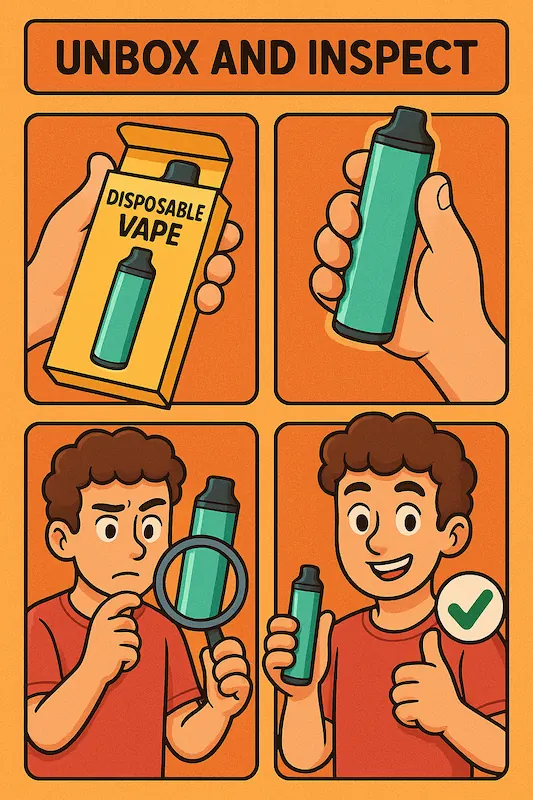
The first important step with any disposable vape is to check it carefully when you take it out of the box. This helps to avoid common problems that beginners have, like poor airflow or bad smells.
- Remove Protective Components: Take the device out of its box carefully. Look at the mouthpiece and base. See if there are any silicone plugs or dust caps on them. These disposable vape safety covers must be fully removed to make sure air can flow through easily. If you leave them on, they can stop too much air from getting in.
- Clear Condensation Gently: Tilt the device 45° with the mouthpiece facing down and give it 2-3 light taps with your wrist (like tapping a dripping pen). This explains how to remove condensation from disposable vapes. Condensation is natural vapor runoff, not a defect, but trapped liquid can cause coughing or sputtering. Give it a gentle shake, especially after shipping, to clear the airway without damaging the inside.
- Prime the Coil Properly: Leave the vape flat for one minute so that the coil can soak up the e-liquid. For devices with a mesh coil, reduce the priming time to 30 seconds because of their better wicking efficiency. This stops it from going dry and makes the first puff taste better.
Step 2: Activating Your Device — Simple Techniques for Smooth Starts
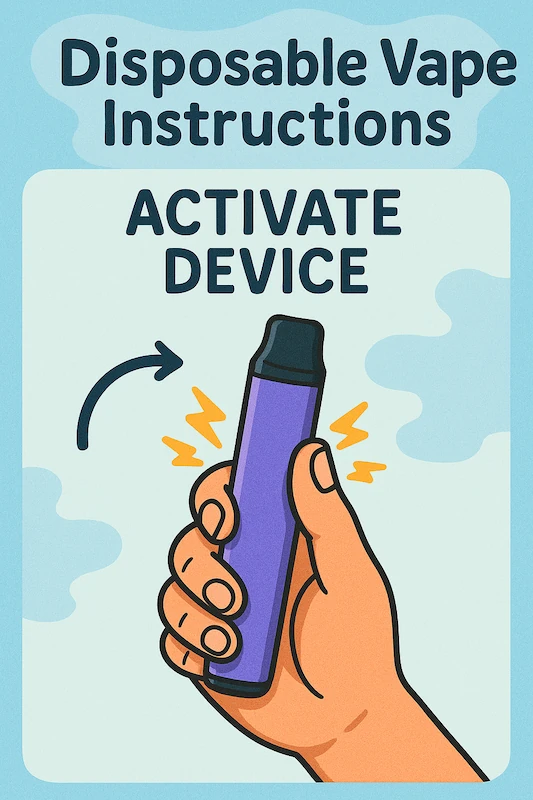
Proper activation is key to a seamless vaping experience, with two main types:
- Draw-Activated (Most Models): Most vapes can be used without pressing any buttons. Place the mouthpiece between your lips and breathe in slowly (2-3 seconds), as if you are sipping coffee. Airflow sensors automatically start vapor production, which is perfect for beginner vape users who want a cigarette-like experience.
- Button-Activated (Rare Rechargeable Models): Some high-power, disposable-style rechargeable vapes have a power button. To unlock, click the button five times quickly (the LED will flash three times). Hold the button while you inhale to control how strong the vapour is. This is a feature for experienced users. To avoid wasting battery power, always read the manual.
Activation Best Practices:
- Test Puffs: Take 1-2 gentle breaths first to check the vapor density and how well it works, to avoid any coughing.
- Safety Shutdown: For button-activated models, turn off after use (press the button five times) to avoid accidental activation in pockets. This will also make the battery last longer.
Step 3: Mastering Inhalation — Posture and Technique for Optimal Flavor
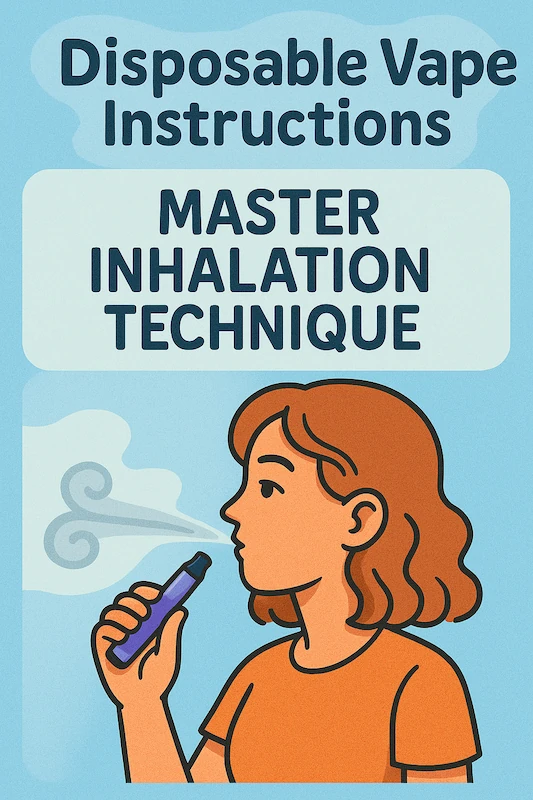
If you get your inhale right, you can make your taste 50% better and avoid problems like leakage or sore throat.
- MTL (Mouth-to-Lung) Inhalation:
- Slowly pull the vapour into your mouth (at a speed of 1 cm/s), and hold it for 1-2 seconds to enjoy the initial flavour (e.g., tobacco or strawberry).
- Exhale (blow out) through your throat into the lungs, but don’t use your nose (that’s for direct lung draws). This method reduces the amount of vape that goes into your throat, making it easier to inhale vape without coughing.
- The 45° anti-leakage angle is perfect for preventing unwanted drips and spills. Hold the device with the mouthpiece tilted 45° upward, so that it matches the shape of your hand. This uses gravity to keep condensation in the atomizer base, so there is less waste and you can get a quiet, smooth vape pull – even when you’re texting or lying down.
Advanced Tips:
- Puff Timing: Try to hold your breath for 2-4 seconds. If you hold it for less than 2 seconds, you won’t get much vapour. If you hold it for more than 4 seconds, you might overheat the coil.
- Mouthpiece Care: If there is any minor condensation, just wipe it away with a tissue. This is normal for all vapes and you don’t need to take anything apart.
Step 4: Monitoring Device Status — Prevent Issues Proactively
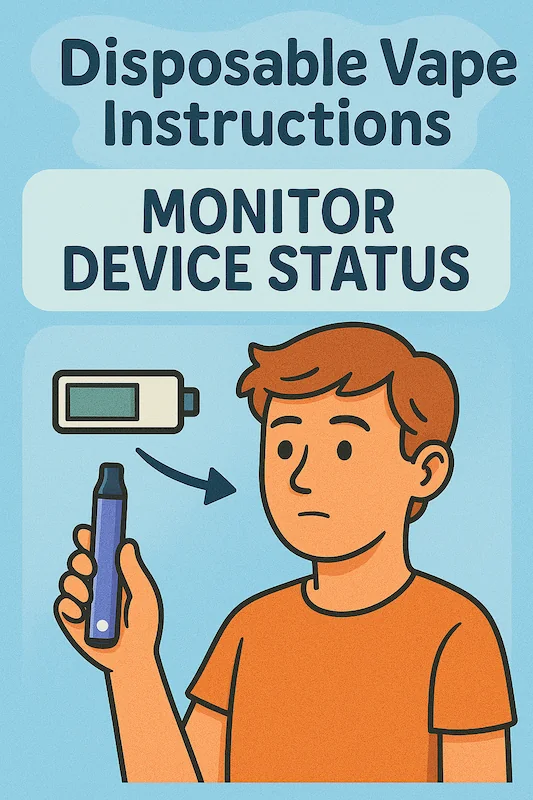
If you understand your vape’s signals, you can avoid most unexpected problems:
- LED Indicator Meanings:
- Rapid Flashing (5-10x): This is a signal that the battery is low (for rechargeable models). Use the charger that comes with the product—don’t use third-party cables.
- Continuous Flashing During Use: This could be a dry coil or empty e-liquid. Flick to clear the condensation and replace if the liquid level is low.
- Overheating Prevention: Don’t vape in quick succession (three puffs in ten seconds) or in temperatures over 30°C. If the device feels hot, stop for 5 minutes – the e-liquid can be damaged, and the battery can be ruined by overheating.
- E-Liquid Depletion Signs: If the vapor is weak, the taste is burnt, or the sweetness has gone, it’s time to replace it. If you get a dry hit, it can damage the coil. So dispose of non-rechargeable models straight away.
Pro Maintenance Tips:
- Carry a Spare: This is important for long trips or busy days to avoid having nothing to do.
- Troubleshoot Gently: If the LED doesn’t work but the liquid and battery are fine, gently tap the base. This is because shipping vibrations might have caused small problems.
Maintenance Tips to Extend Disposable Vape Lifespan
Proper Storage Ensures A Longer-lasting Experience
If you look after your vape and store it properly, you can make it last longer and make sure it works well. You can also stop it from leaking and breaking. Here is a simple guide for different situations:
1. Storage Fundamentals: Environment Determines Longevity
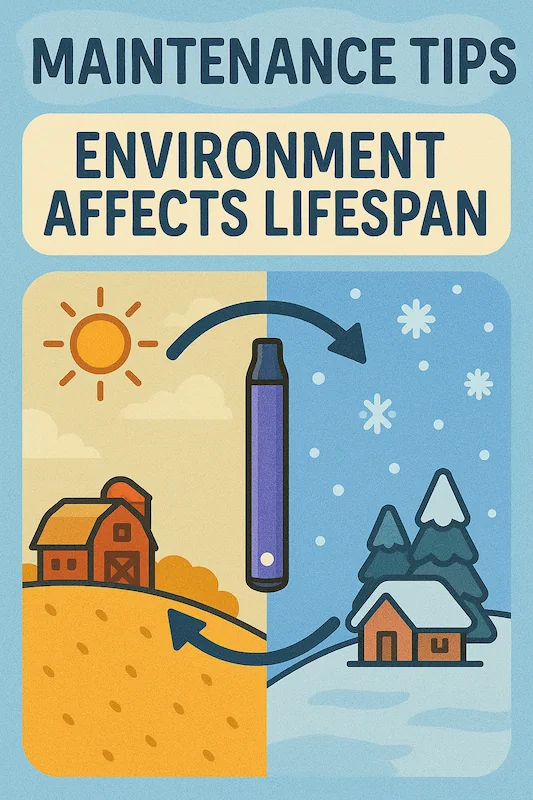
① Avoid High Temperatures
Heat is dangerous for disposable vapes. If you leave them in places where it is hotter than 30°C (like on a car dashboard or a windowsill in the sun) for a long time, the e-liquid will evaporate quickly (which makes the flavour go bad), the battery will get worse, and there is a risk of it swelling or leaking. Store devices upright in a cool drawer or case (mouthpiece up to minimise condensation). At home, choose a dresser for your bedroom. When you’re on the move, avoid storing things in tight pockets (body heat can also affect performance).
② Keep It Dry and Protected
Moist places like bathrooms and kitchen sinks can cause problems. A wet coil might make a hissing noise, and rusty contacts can stop air from getting through. If the device gets wet, dry it straight away with dry tissue—never use a hairdryer (heat can damage the inside). If you’re storing it for a long time, put a packet of food-grade desiccant (like silica beads) in a sealed bag to stop it from getting wet.
2. Safe Storage: Prevent Accidents and Access
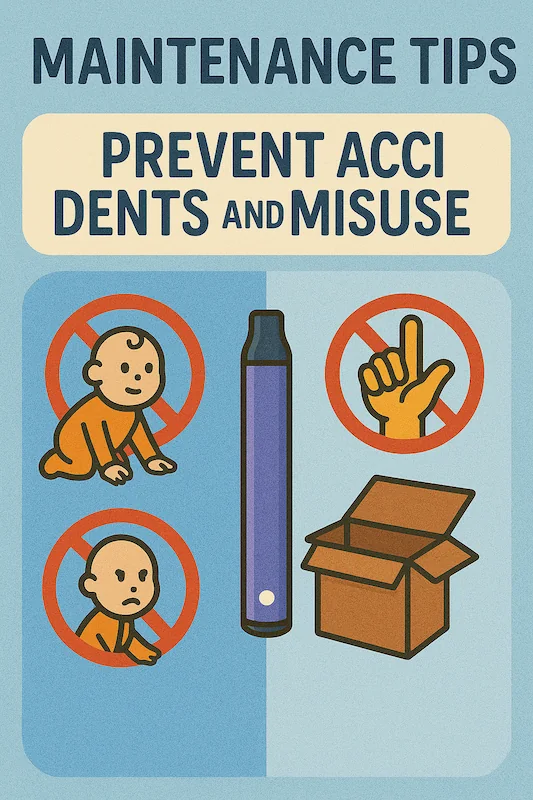
① Child and Pet Safety
Always keep vapes locked away, in a high cabinet or a secure container. This is because fruity e-liquid smells can attract children and pets, and nicotine can be poisonous. Make sure you dispose of empty devices properly so that people can’t get hold of them.
② Travel-Friendly Protection
When you’re out and about, use a special protective case (silicone or hard plastic). This protects the mouthpiece from scratches by keys or coins and prevents it from being switched on by accident (especially for button-activated models). When you carry vapes in bags, put them in a side pocket that’s separate from other things and away from liquids and moisture.
3. Routine Inspections: Early Issue Detection
① Quick Pre-Use Checks (3-Second Routine)
Before each use, visually inspect:
- Use a cotton swab to clean off any brown/yellow residue (this could be from condensation or spoiled e-liquid).
- The device is slightly warm, which is normal. If it is too hot, stop using it immediately.
- Does it have a stiff draw? Check for protective caps and clear condensation.
② Follow The Manufacturer’s Guidelines
Brands may have different recommendations. Some say you should use opened vapes within 1-2 weeks for the best flavour, while rechargeable models might need to be charged for different amounts of time (e.g., ≤1 hour to avoid battery damage). Keep the packaging and look at the “Storage Conditions” label (e.g., cool, dry, out of reach of children).
Bonus Tips: Maximize Usage Period
- Short-Term Cooling Storage: If you won’t be using it for a short time, store it in a sealed bag in the refrigerator (5-10°C). Leave it for 20 minutes at room temperature. This will stop condensation from forming inside.
- Long-Term Prep: Keep vapes that have not been opened sealed. For vapes that have been used a little bit, remove any condensation, clean the mouthpiece with a cotton swab, and store them in a cool, dry place.
Emergency Troubleshooting: Quick Fixes for Common Issues
1. Leakage Solutions — 3 Steps to Clean and Restore
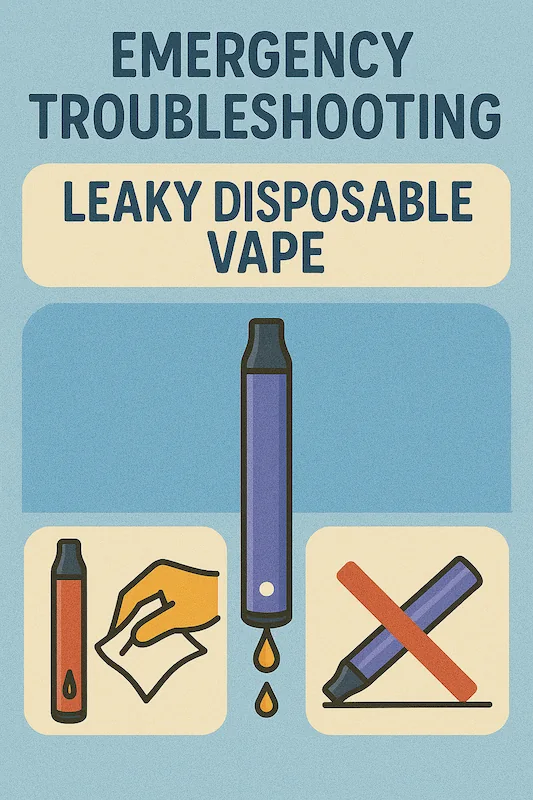
① Gravity-Assisted Drainage
If liquid comes out of the mouthpiece or base, tilt the device 45° downward and give it 2-3 gentle taps with your wrist (like tapping a pen). This removes excess e-liquid from the airway, which is great for dealing with condensation (which is common with mint and fruit flavours that generate more condensation). Note: If the e-liquid is yellow or brown, it may be spoiled. Do not use it.
② Thorough Cleaning
Use a cotton swab or a soft tissue to gently clean the inside of the mouthpiece and the airway entrance (do not poke the coil). If there is oil near the charging port, use a dry cloth to remove it. Never rinse with water, as this can damage the internal components.
③ On-the-Spot Hack
If you don’t have one, you can use a lint-free cloth or even the corner of a clean handkerchief. After wiping, take a small puff to make sure there’s no liquid left.
Prevention Priority: Make sure you always store devices upright. This will help to stop them leaking because of expansion.
2. Burnt Taste Remedies — Act Swiftly to Avoid Risks
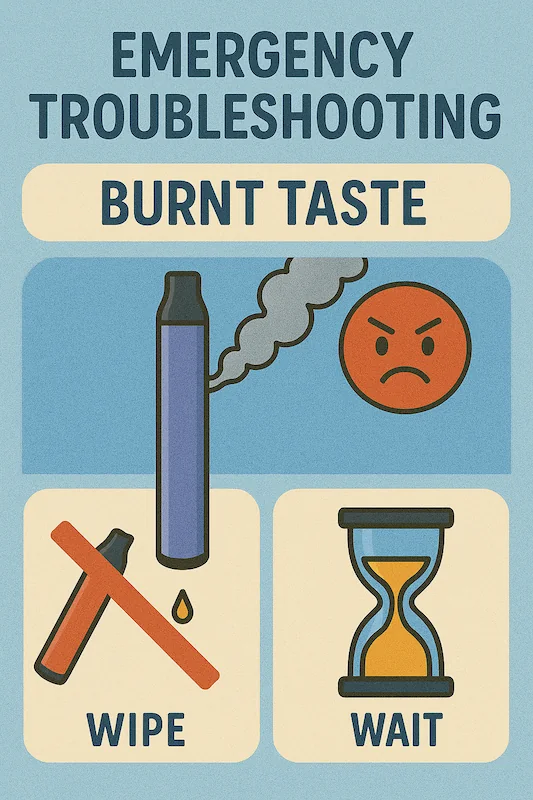
① Immediate Shutdown and Diagnosis
If you can smell burnt plastic, it means that the coil is burning without any e-liquid.
- E-liquid Remaining: Flick to clear the condensation and let the device sit for one minute to re-wick the coil (this is important for devices that have not been used for a long time or have not been used properly).
- Empty Device: Replace it immediately (non-rechargeable models cannot be repaired; rechargeable ones should be replaced even if charged, to avoid harmful byproducts from dry burning).
② Avoid Chain Vaping
Wait 15-20 seconds between puffs (count aloud to keep track) to let the coil soak up the e-liquid. High-nicotine or high-vapor models are more likely to cause coil burnout if you inhale too quickly.
③ Preventive Coil Priming
Make sure you always set up new devices in the way explained in the Usage Guide, step 1. If the vapor production gets weaker or it becomes harder to breathe in, replace the device straight away to avoid the risk of it burning dry.
Emergency Response Principles
- Safety First: If your device is leaking or overheating, get rid of it right away. If you buy it from someone who isn’t an official seller, check that it is certified.
- Brand Feedback: If you have a problem that keeps happening, contact customer support. Reputable brands will usually provide replacements or advice.
- Spare Device Ready: Make sure you have a new vape ready for important occasions, so you don’t have to stop vaping.
Health and Safety Considerations for Disposable Vapes
Health Warnings — Alarming Nicotine Addiction Risks in Adolescents
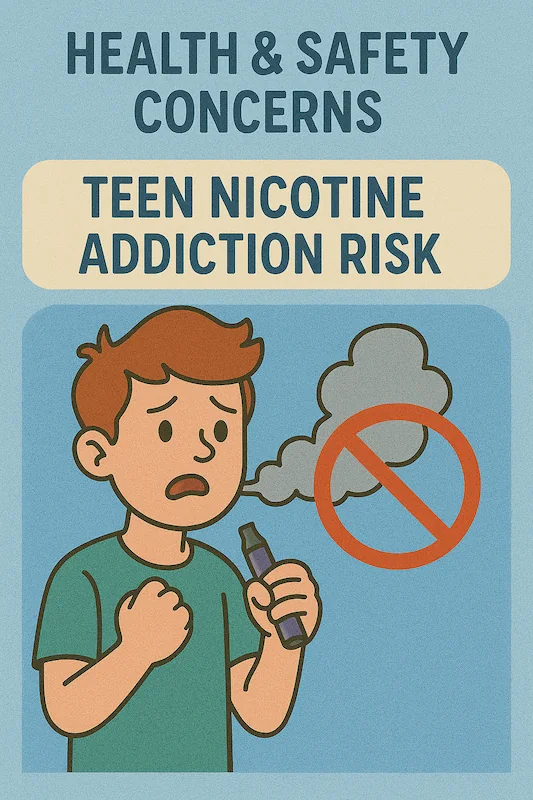
Research shows that teenagers are much more likely to become addicted to nicotine from vaping than adults are, because their brains are more sensitive to nicotine (Nature Reviews Neuroscience, 2020). A 2021 study in Nicotine & Tobacco Research found that people who use both vapes and cigarettes are more dependent on nicotine than people who only smoke cigarettes. This shows that vapes can make it easier for young people to get addicted. The brain of an adolescent is not fully developed. Just one instance of exposure to nicotine can cause changes in the brain’s reward system, which can increase the risk of ADHD. Even low-nicotine disposable vapes (common strengths: 1.5%-2%, with 5% permitted in some regions under local laws), featuring fruity flavors like methyl levulinate, may make nicotine more addictive.
Prevention Strategies:
- Parents should store devices in locked cabinets and check that they are not being sold to people under 18.
- Schools can use programmes based on neuroscience to teach teenagers about the risks of vaping to their brain development.
Vapes are for adults who want to reduce the harm from smoking, not for teenagers. It’s important to understand how nicotine can harm the developing brain. If you want to use nicotine safely, you need to put your family’s well-being first.
Ingredient Risks — Long-Term Respiratory Effects of Propylene Glycol (PG)
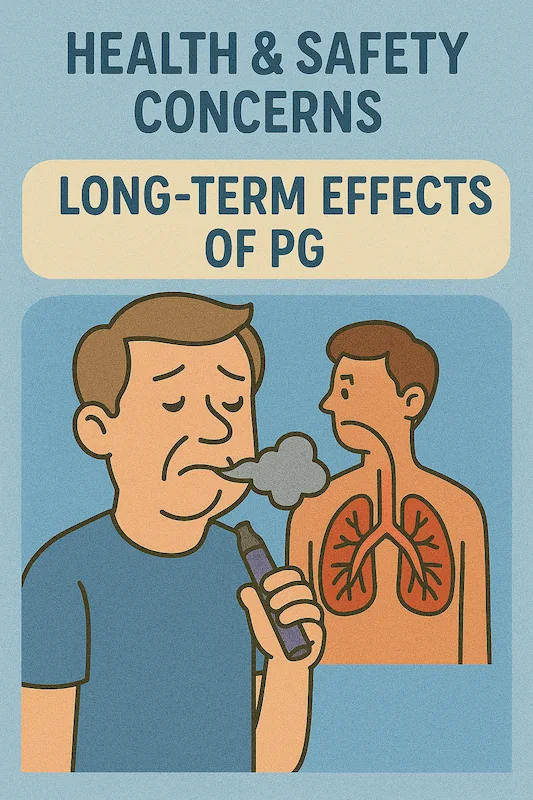
Propylene glycol (PG) is approved by the FDA for use in food, but it is important to be careful because it is dangerous to breathe in. High levels of PG (more than 50%) can change the behaviour of a type of immune cell in the lung, which could potentially lead to a condition called pulmonary fibrosis. It’s important to note that these results are based on single-ingredient, high-dose exposures, which is different from what happens in the real world with PG/VG mixtures (common ratios: 3:7 to 5:5). Vegetable glycerin (VG) is less irritating, but it can build up in the lungs because it is thick. Using e-cigarettes for a long time and often may be bad for your health.
Usage Recommendations:
- Choose e-liquids made with less than 30% PG and at least 60% VG (for example, “high VG low PG” blends). This will reduce your exposure.
- Don’t use more than 300 puffs in one day. And take a 10-minute break every hour to help your breathing.
- Stop using this medicine right away and see your lung doctor if you still have a cough or trouble breathing.
It is very important to understand the different choices involved in choosing the ingredients. While disposable vapes are convenient, it’s important to make informed choices that balance quitting with protecting your health.
Contraindications — Vulnerable Groups Must Avoid Vaping
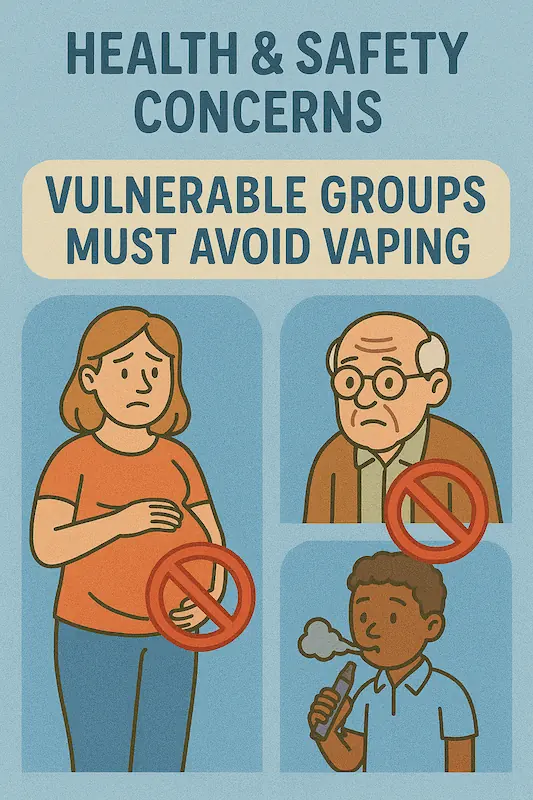
Vapes are not safe for the following groups of people because there is proof that they can make people sick:
- Pregnant Women
Nicotine passes from the mother to the baby through the placenta. It can disrupt how the baby’s neurons connect, which can increase the risk of learning disorders. Vape aerosols contain 10 times less formaldehyde than cigarettes, but they can still cause inflammation of the placenta. Even “nicotine-free” vapes may have small amounts of nicotine (the limit for detection is 0.01mg/ml), and it is not known whether flavour chemicals are safe for pregnant women.
- Cardiovascular Disease Patients
Vaping can increase the risk of heart disease and the risk of irregular heartbeats. Using this for a long time can make your heart failure go up by messing up the calcium signals in your heart muscle cells. Nicotine can make your blood pressure go up by 5-7 mmHg in people who already have high blood pressure.
- Strict Avoidance Guidance:
- If you are pregnant, you should not vape or breathe in other people’s vape smoke. This is because nicotine can stay in the air for more than three hours.
- If you have a heart problem, you should use nicotine replacement therapy (NRT) that is approved by the FDA. This means things like nicotine patches or gum. These are safe because they have been tested.
Environmental Disposal Methods for Disposable Vapes
Proper Recycling of Disposable Vapes
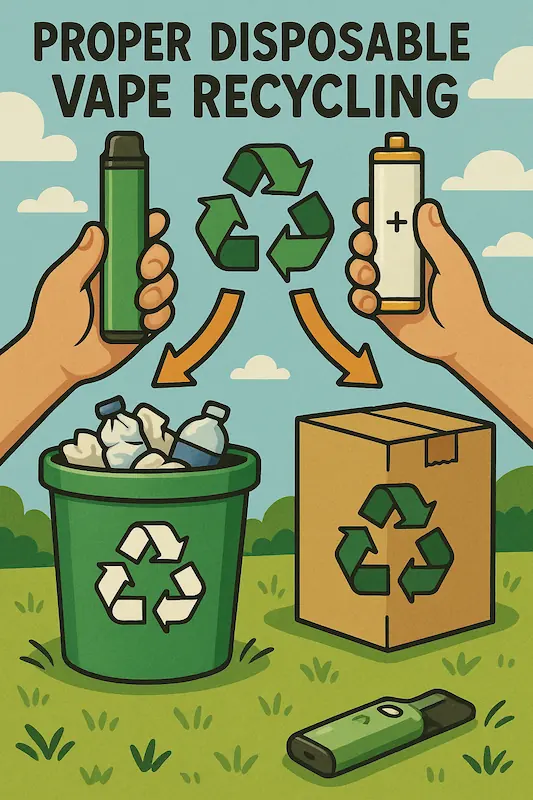
Disposable vapes contain nicotine solutions and lithium batteries, which are classified as hazardous electronic waste. If you don’t dispose of them properly, there’s a risk of fire, soil contamination, and water pollution. Follow these steps to make sure you’re eco-friendly:
- Never Trash Disposable Vapes
Please do not throw used vapes in the regular rubbish. Lithium batteries can catch fire if they are put under pressure or if they get too hot (for example, in landfills), while leaked nicotine can harm soil ecosystems. Even devices that seem empty need to be handled with care because they can still be dangerous. - Use Certified Recycling Channels
- Local Hazardous Waste Facilities: Visit your city’s environmental department website or call 311 to locate nearby e-waste drop-off points (often open on specific monthly dates).
- Retailer Take-Back Programs: Brands like JUUL and Vuse offer free recycling via mail-back kits. You can find prepaid labels on their websites.
- Community E-Waste Drives: Watch out for recycling events organised by local governments or charities, such as Earth Day campaigns. These events usually take vapes, phones, and batteries.
- Compliance Tips for Safe Disposal
- Do Not Disassemble: Professional recyclers have special equipment to safely handle components. Make sure you don’t break the devices. You can only take out the batteries if the device says you can (this is rare with disposable devices).
- Seal Before Transport: Wrap the vape in anti-static film or put it in a bag that won’t be damaged if it’s squashed. Put the label on it that says ‘Contains Lithium Battery’ so that the people who are going to handle it know.
- Regional Regulations: In the EU, vapes are covered by the WEEE Directive, which says they must be recycled through ECRA-certified centres. In the U.S., California’s CEW program sets out how vapes must be disposed of properly.
The Double Impact of Responsible Recycling
If you dispose of them properly, you can help protect the environment and support the circular economy. Recycling 1 ton of vapes can recover 0.8kg of lithium and 50kg of stainless steel, which can cut raw material costs by 30% (EU Circular Economy Action Plan). Every time someone recycles a vape, it gets us one step closer to finding sustainable smoking alternatives.
Take Action: Use our map below to find your nearest recycling point. If you choose to recycle, you can help reduce the amount of “vape waste”.
Dangers of DIY Disassembly — 3 Key Risks
Disposable vapes are designed with built-in safety barriers. Changing them breaks the rules set out and puts users at risk:
- Lithium Battery Thermal Runaway
The compact lithium battery (3mm thick) inside vapes can ignite when it is punctured or short-circuited. A 2023 CPSC report found that 32% of vape fires started because users took the device apart, which made the temperature go up to 400°C really quickly. This released a toxic gas called hydrogen fluoride. - Toxic Nicotine Exposure
If the e-liquid chamber is broken, it can release a liquid with 5% nicotine salt in it (the pH level of this liquid is between 5.5 and 6.5). This liquid can burn the mucous membranes in the mouth and throat. The Poison Control Center says that 0.1ml (100mg) of pure nicotine can kill an adult, and that 2ml can kill a child. - Device Malfunctions
If you force open the sealed casing, you can damage the O-rings, which are designed to be leak-proof. This can cause problems:
- Electrical shocks: If the circuits are worn out, you may feel a tingling sensation when you use them.
- Dry burns: If you heat coils without using e-liquid, they can produce harmful chemicals.
Safety Protocol:
- For models that are switched off, press the power button five times quickly.
- Seal it in a bag that has a label on it and that is anti-static.
- Take your e-waste to a certified facility. Don’t try to repair or modify it.
How to Choose High-Quality Disposable Vapes
Safety And Compliance From A Certification Standards Perspective
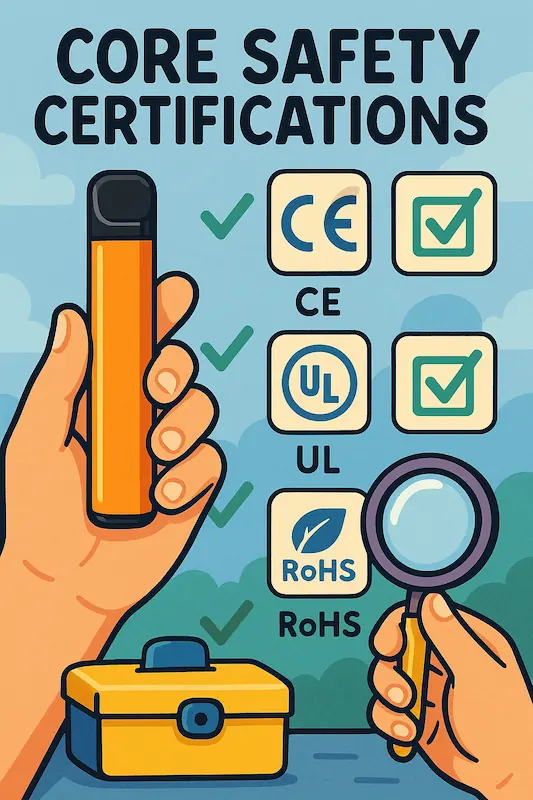
Core Safety Certifications: The Pillars of Trusted Vaping
- EU TPD Directive (2014/40/EU)
- Key Requirements: Limits nicotine to ≤20mg/mL, e-liquid capacity to ≤2mL, and bans harmful additives like diacetyl. Battery safety must comply with EU RoHS and Battery Regulation (2006/66/EC).
- Verification: If you want to sell products in the EU, they need to have CE-TPD certification. This means they must have a warning label that says, for example, “Contains nicotine, an addictive substance.” Check that certifications are valid using the EUDAMED database.
- US FDA PMTA Certification
- Stringent Review: The law says that ingredient toxicity reports, emission tests (e.g., formaldehyde ≤ 0.4 ppm, acetaldehyde ≤ 20 ppm), and risk assessments must be submitted. By September 2024, these products must be fully compliant.
Battery and Electrical Safety Standards
- UL 8139 Certification: The best e-cigarette safety features include protection against battery overheating, short-circuit protection, and thermal runaway prevention.
- UN 38.3 Compliance: Lithium batteries must pass transport safety tests. These include tests for high temperatures, vibrations, and impacts.
Ingredient Purity and Health Compliance
- FDA GRAS Certification: The ingredients in e-liquids (PG/VG) must meet the Food and Drug Administration’s standards for being safe for food-grade use.
- RoHS 3.0 Certification: It limits the amount of dangerous substances (like lead and mercury) in coils and electronics. This is a legal requirement for the EU and Chinese markets.
Practical Buying Guide: The 3-Step Filter
- Label Verification:
- Check if there are any certifications for the target market (e.g., EU TPD number, US PMTA ID) and Chinese labels for imports.
- Authorized Retail Channels:
- Don’t buy products from informal sellers that don’t have a brand name. Choose well-known websites, licensed online shops, or physical shops that are approved by the government.
- Red Flag Detection:
- The term ‘nicotine-free’ is used to describe products that do not contain any nicotine, but this cannot be guaranteed until there is a third-party lab report. This is because there may be hidden nicotine or nitrosamines in the product.
- Flavours that are too strong or like chemicals (there might be illegal additives like sucralose or benzoic acid).
- It makes unrealistic claims (e.g., 10,000 puffs from a 2ml e-liquid device, which is mathematically impossible).
Sustainability and Recycling Considerations
- EU New Battery Regulation (2023): By 2027, the cobalt in batteries must be no more than 0.01%, and 16% of the lithium used must come from recycled sources. Look for the “Battery Passport” label.
- Closed-Loop Recycling Programs: Brands like Vuse let you send back empty devices for recycling, which is good for the environment.
Pro Tip: When it comes to safety, focus on products that are certified in multiple countries to make sure they are safe to use across different borders. “Bargain” vapes that don’t have a certificate are often made with lower-quality batteries and coils.
Key Specs Breakdown for Smart Purchasing
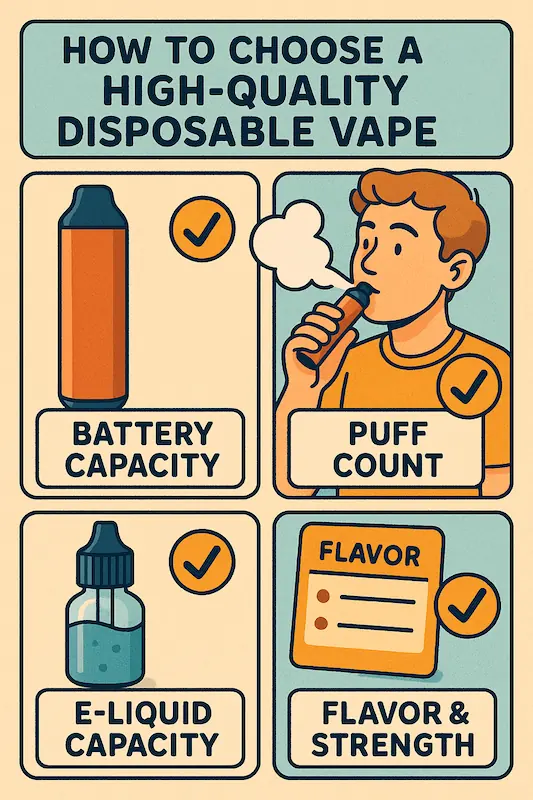
Puff Count vs. Reality
- Calculation Rule: The puff count is the same as the e-liquid volume (in millilitres) multiplied by 200 (for example, 5 millilitres equals around 1,000 puffs). Claims that are more than 50% higher than this are probably exaggerated.
- Usage Tiers:
- Light users: There are 10,000 puff models, for example, the Uwin Crystal 10K Puffs Disposable Vape, which you can use 300 times a day without having to replace it often.
- Heavy users: There are over 30,000 puff models (for example, Fumot RandM Tornado 30K Puffs), but check the e-liquid capacity (for example, 12 millilitres for 10,000 puffs).
Battery and Rechargeability
- Disposable vs. Rechargeable: True disposables are non-rechargeable. “Rechargeable disposables” (e.g., JNR Falcon X 18000) fall under the “open-system vape” category, not traditional disposables.
- Energy Efficiency: A 1,000mAh battery should power about 1,000 puffs (1mAh for each puff). High-efficiency models (e.g., Bang Disposable Vape) may achieve 1.5 puffs for each milliampere.
Flavor Safety and Trends
- Global Preferences: Most of the flavour is fruit-based, and the UK/EU markets like their flavours to be complex (like mango-lime ice).
- Safety First: Choose brands that list the flavourings they use, and avoid “mystery” flavours that are popular right now without disclosing what they are made of.
First-Time User Quick Start
Disposable vapes are perfect for people who are vaping for the first time because they are easy to use:
- Unbox and Prepare: Take off the silicone protection cap from the mouthpiece and base to clear the airway.
- Draw to activate: Inhale slowly (2-3 seconds) to trigger the airflow sensors—no. No buttons needed (most vapes are draw-activated disposable vapes).
- End-of-Life Signs: If the LED (red/white) flashes, there is a problem with the battery or the e-liquid. Replace when the vapour becomes thin or the flavour fades (e.g., when the mint flavour becomes less strong).
Safety Note: Disposable batteries are designed to be used only once. Do not try to recharge or refill non-rechargeable batteries.
Disposable vapes show that technology can be fun without being complicated. Whether you’re a complete beginner or looking for an easy option, their simple design means you’ll learn how to use them. Remember: if you use it properly and replace it at the right time, you will have the best experience.
Are you ready to try it? Try out our certified models today and see why so many people love vaping. Share this guide with new vapers to help them enjoy vaping easily!
FAQ: Common Questions About Disposable Vapes
How to Identify an Exhausted Disposable Vape?
Recognize these key indicators of a depleted disposable vape:
- No Vapor Production: If there is no vapor when you inhale, it could mean that the e-liquid is empty or the battery is dead (this is often the case with non-rechargeable models).
- Diminished Vapor Output: The vapor is thin and weak (e.g., barely visible mist), and the flavors have significantly faded (e.g., 80% less mint coolness).
- Burnt Taste Sensation: If your vape tastes like plastic, it’s probably because the coil is burning too hot. This is often caused by not using enough e-liquid or vaping too quickly.
- LED Indicator Alerts: If the battery is low, the LED light may flash red. If there is not enough e-liquid, the LED light may flash white. The frequency of the blinks can vary, for example, 3 times per second or a steady glow.
Why Does My Vape Taste Burnt? Should I Continue Using It?
Primary Causes of Burnt Flavor in Disposable Vapes:
- E-Liquid Depletion: The atomizer coil can burn without e-liquid, releasing harmful byproducts.
- Excessive Chain Vaping: If you inhale too quickly, the coil can’t cool down properly, which can lead to overheating and damage.
- Storage-Related Leaks: Improper storage may cause e-liquid to leak, damaging the coil over time.
Critical Safety Warning: Stop using it immediately! Burnt vapor may contain higher formaldehyde levels, increasing respiratory and carcinogenic risks. Dispose of the device and switch to a new one.
How to Safely Recycle Disposable Vapes? Can I Disassemble Them?
Environmentally Responsible Disposal Steps:
- Hazardous Waste Classification:
- This contains two types of hazardous waste: lithium batteries and nicotine solutions. You can dispose of both of these in the “Hazardous Waste” bins that are marked with a ⚠️ or at the e-waste recycling points.
- Brand Take-Back Programs:
- Brands like JUUL and Vuse offer free mail-back services—download prepaid labels from their websites.
Do Not Disassemble! Risks Include:
- Fire Hazard: Short-circuited lithium batteries can reach temperatures of over 200°C, which can ignite nearby materials.
- Nicotine Toxicity: 1ml of pure nicotine solution can poison adults (LD50: 50mg/kg), with 2ml being fatal to children.
- Environmental Contamination: Leaked PG/VG damages soil microorganisms and water systems.
Can I Carry Disposable Vapes on Flights?
- Europe (EU TPD Compliance):
- Permitted in carry-ons only (prohibited in checked luggage).
- Greece and others enforce nicotine ≤20mg/mL—no prescription required.
- USA (TSA/FAA Rules):
- Allowed in carry-ons (must be in carry-on bags for screening).
- 2024 FAA Update: Prohibited in checked bags; must be powered off to prevent accidental activation.
- State variations: California limits nicotine to ≤60mg/mL.
Travel Tips:
- Store vapes in anti-static bags to avoid button activation.
- E-liquid bottles must comply with airline liquid restrictions (≤100mL).
